| Pages:
1
2 |
Morgan
International Hazard
    
Posts: 1660
Registered: 28-12-2010
Member Is Offline
Mood: No Mood
|
|
Quote: Originally posted by MrHomeScientist  | That quick clay demo is very cool, I'd never heard of that before. That would make a great hands-on demonstration for my outreach program. Anyone know
if that stuff is for sale someplace? Geologist supply store? Anyone live in Norway that could dig some up?
The menthol and camphor demo is very cool too. I'd like to try that if I ever get menthol. |
The blasting of quick clay is sort of like the hammer effect I saw with a thixotropic material. It would be funny to mold certain shapes like large
toy army men or zombie figurines or something like a vase and then whack them with a hammer.
https://www.youtube.com/watch?v=3q-qfNlEP4A#t=16m51s
|
|
|
mayko
International Hazard
    
Posts: 1218
Registered: 17-1-2013
Location: Carrboro, NC
Member Is Offline
Mood: anomalous (Euclid class)
|
|
I made a serenditipous observation while I was packaging my magic rocks gifts this Christmas I noticed that hydrated calcium chloride would appear to react with other salts it was packaged with,
generating moisture. I've done a few experiments and have come up with some cool results. It's not the most striking of chemical demonstrations, but
it uses chemicals which are likely to be on hand for even an austere DIY lab (unlike barium hydroxide or menthol/camphor, for example), and it has
pedagogical relevence (to illustrate Le Chatlier's principle, or water of crystallization)
The general system relies on the reaction between two salts with high solubility and many waters of crystallization, to produce salts with low
solubility and little if any water of crystallization, effectively releasing stored water. The most thoroughly explored subsystem involves hydrated
calcium chloride with a hydrated metal sulfate:
$$CaCl_2.6H_2O + MSO_4.xH_2O -> CaSO_4.2H_2O + MCl_2 + (x+4) H2O$$
This seems to be catalyzed by trace moisture, provided in my case by slightly moist calcium chloride (no amount of acetone and/or pressing between
blotters seems to dry out the salt I've recrystallized) or perhaps by ambient humidity (breathe on the reaction mixture to kickstart it?) Once the
reactants dissolve slightly, the reaction is driven forward by the precipitation of insoluble calcium sulfate. The water released presumably
accelerates the reaction by dissolving the reactants, and also further releasing water of crysallization in the dissolved salts.
Four examples of this subsystem were investigated by mixing the salts in a 1:1 molar ratio, adding to a test tube, sealing, and shaking to mix:
| Code: |
M x
I. Cu 5
II. Mg 6
III. Fe 7
IV. Na2 10
|
I. $$CaCl_2.6H_2O + CuSO_4.5H_2O -> CaSO_4.2H_2O + CuCl_2 + 9H_2O$$
This quickly became slushy, and I have a tube from one experiment in which this intermediate state left splashmarks on the sides of the tube. The
mixture then seems to harden into a gummy-looking green plug of gypsum and copper chloride. Over a long time, the plug oozes fluid, but it would be
hard to call the reaction a liquification.
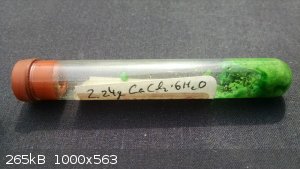
II. $$CaCl_2.6H_2O + MgSO_4.6H_2O -> CaSO_4.2H_2O + MgCl_2 + 10 H_2O$$
This also quickly liquifies and then resolidifies into a grainy paste.
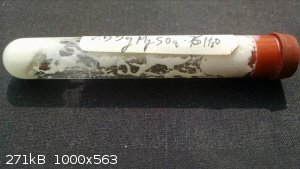
III. $$CaCl_2.6H_2O + FeSO_4.7H_2O -> CaSO_4.2H_2O + FeCl_2 + 11 H_2O$$
This became “sweaty” looking and shrank into yellow, chalky-looking plug. It is rimmed with an orange color near the surface, possibly from Fe2+
reacting with oxygen in the test tube atmosphere. Not much in the way of free moisture is ever seen.
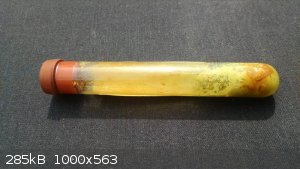
IV. This mixture fully liquifies into the consistency of Elmer's glue, remaining pourable. Over several weeks, transparent aqueous solution.
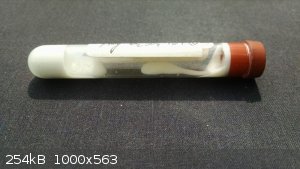
I also tried trisodium phosophate (Na3PO4 * 12H2O). Calcium phosphates are pretty insoluble, but it's not obvious the specific compound or mixture
produced by this reaction ([url= https://en.wikipedia.org/wiki/Tricalcium_phosphate#Preparati... ]Wikipedia claims it's not tricalcium phosphate[/url] )and thus it's not obvious
what the optimal stoichiometry is. I treated it as though it was producing tricalcium phosphate, and the intermediate stage was the most mobile and
wet I saw, though it ultimately hardened to a paste. I also tried sodium tetraborate (Na2B4O7 * 10 H2O), but no reaction was observed at all.
Overall, IV. was the only mixture which I'd say reliably liquifies. However, I was able to get I.to form a lot of liquid water by layering the solids,
rather than mixing them. I used a small enough tube that the layer of calcium sulfate that forms on the interface of the reactants tended to act like
an arch which kept them out of contact, so the tube required frequent thumping to keep them in touch. Eventually it separated into distinct layers:
moist copper sulfate, waterlogged copper sulfate, two distinct layers of calcium sulfate, an olive-green liquid layer, and what started out as
undissolved calcium chloride but now looks like calcium sulfate sediment. I am trying this again right now in a larger tube, with the calcium chloride
in the top layer, so that as it deliquesces the liquid flows downward and reacts (rather than simply pooling).
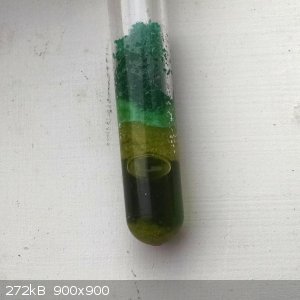
I've actually come to really like these reactions, even when they don't fully liquify. They're like mineralogical equivalent of a closed ecosystem
display (http://www.instructables.com/id/How-to-Make-a-Closed-Aquatic...), which slowly develops over days or weeks. I'm putting together a time-lapse I
filmed of reaction I. taking place; I'll post an animated gif of it soon!
I have a more rigorous, algebraic discussion of what's going on here that I'll post if people are interested enough for me to wade through the markup

al-khemie is not a terrorist organization
"Chemicals, chemicals... I need chemicals!" - George Hayduke
"Wubbalubba dub-dub!" - Rick Sanchez
|
|
|
mayko
International Hazard
    
Posts: 1218
Registered: 17-1-2013
Location: Carrboro, NC
Member Is Offline
Mood: anomalous (Euclid class)
|
|
This came from a longer handbook from University of Wisconsin cowritten by Don Showalter, the chem demo guy from World of Chemistry. It's surprisingly
obscure and I could only get it piecemeal through interlibrary loan. But this was my core interest: a reaction in which ~20g each of iron (III)
nitrate, mercury (II) chloride, and tin (II) chloride are layered in a large test tube. When the tube is shaken to mix, the reaction mixture liquifies
into a thick yellow fluid which gets burped out of the test tube and down the side as nitrogen dioxide is evolved. When the reaction is over, the
mixture solidifies into a tough yellow solid. The main reaction is apparently between the iron and tin salts, with the mercury chloride acting as a
catalyst. This is given but ... I don't think it's balanced (products are short by 7H2O)
2[Fe(NO3)3*9H2O] +3[SnCl2*2H2O] -> 3SnO2 + 6NO2 + 5H2O + 2[FeCl3*6H2O]
I saw this once when I was very young and it made a big enough impression on me to track it down all this time later! I wonder if gallium or similar
could be swapped out for the mercury for a "greener" demo?
Attachment: A solid State Reaction - old Belcher.pdf (582kB)
This file has been downloaded 275 times
al-khemie is not a terrorist organization
"Chemicals, chemicals... I need chemicals!" - George Hayduke
"Wubbalubba dub-dub!" - Rick Sanchez
|
|
|
| Pages:
1
2 |
|